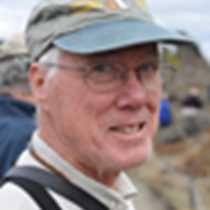LeConte Glacier, Southeast Alaska
Last night the Sea Lion departed Juneau and we began our passage southward. Early in the morning we “crossed the bar,” the end moraine left behind by the LeConte glacier to enter LeConte Bay. This fjord cuts into the mainland of Alaska and ends at the face of the mighty LeConte glacier. In recent years, the LeConte was Alaska’s fastest moving glacier, the ice moving forward ninety feet a day and calving an equal amount of ice into the fjord, clogging the bay with an impenetrable mass of ice. The glacier seems to have slowed its movement, and the Sea Lion was able to continue until the enormous glacial face came into view – closer than we have been in years. It was off in Zodiacs for cruises through ice of all descriptions … white ice, clear ice like the finest crystal, blue ice seemingly glowing with light from within; flat pieces of ice and ice in phantasmagorical shapes - here a duck, there a sphinx, and over there the Taj Mahal; ice carrying stones picked from the mountains above, and ice with harbor seals warily watching us with their large dark eyes. We watched small pieces fall from the face, waiting and hoping for “the big one.” Finally, just before our departure, the ice rewarded our patience. The glacial face began to break away in huge chunks that crashed into the water below with a great roar, splash, and a wave that rocked our black boats; they suddenly seemed very small!
A short distance from the LeConte is the town of Petersburg. No trinket and t-shirt shops here; Petersburg is a working Alaskan fishing community where “friends don’t let friends eat farmed salmon.” Fishing boats fill the harbor (seiners, trollers, gill-netters, long-liners, and crabbers), and waste from the fish processors attracts hordes of gulls, ravens, eagles, and one enormous bull Steller’s sea lion. Our afternoon in Petersburg was rich in activities – floatplane rides over the glaciers, a tour of one of the processing houses, a walk on the docks to see the boats and engage a local fisherman in conversation. Many crossed the channel for a walk along a boardwalk (more accurately plankwalk) trail to reach a muskeg bog. Here, drainage is poor, the soil is saturated, and only stunted, acid-tolerant plants can survive. But what a wonderful assemblage of plants: bog blueberries, bog cranberries, bog rosemary, bog laurel … all over a bed of sphagnum and other mosses. The consistent appearance of “bog” in the names attests to the special nature of the vegetation found here. The star of the day was one of the smallest: tiny red sundews with sticky glands on their round leaves to capture small insects and digest them for an extra dose of nutrients.
Heading south from Petersburg, we entered Wrangell Narrows. It turned in to a beautiful, warm, clear early evening, and we gathered on the foredeck to soak it in. We had EARNED it!
Last night the Sea Lion departed Juneau and we began our passage southward. Early in the morning we “crossed the bar,” the end moraine left behind by the LeConte glacier to enter LeConte Bay. This fjord cuts into the mainland of Alaska and ends at the face of the mighty LeConte glacier. In recent years, the LeConte was Alaska’s fastest moving glacier, the ice moving forward ninety feet a day and calving an equal amount of ice into the fjord, clogging the bay with an impenetrable mass of ice. The glacier seems to have slowed its movement, and the Sea Lion was able to continue until the enormous glacial face came into view – closer than we have been in years. It was off in Zodiacs for cruises through ice of all descriptions … white ice, clear ice like the finest crystal, blue ice seemingly glowing with light from within; flat pieces of ice and ice in phantasmagorical shapes - here a duck, there a sphinx, and over there the Taj Mahal; ice carrying stones picked from the mountains above, and ice with harbor seals warily watching us with their large dark eyes. We watched small pieces fall from the face, waiting and hoping for “the big one.” Finally, just before our departure, the ice rewarded our patience. The glacial face began to break away in huge chunks that crashed into the water below with a great roar, splash, and a wave that rocked our black boats; they suddenly seemed very small!
A short distance from the LeConte is the town of Petersburg. No trinket and t-shirt shops here; Petersburg is a working Alaskan fishing community where “friends don’t let friends eat farmed salmon.” Fishing boats fill the harbor (seiners, trollers, gill-netters, long-liners, and crabbers), and waste from the fish processors attracts hordes of gulls, ravens, eagles, and one enormous bull Steller’s sea lion. Our afternoon in Petersburg was rich in activities – floatplane rides over the glaciers, a tour of one of the processing houses, a walk on the docks to see the boats and engage a local fisherman in conversation. Many crossed the channel for a walk along a boardwalk (more accurately plankwalk) trail to reach a muskeg bog. Here, drainage is poor, the soil is saturated, and only stunted, acid-tolerant plants can survive. But what a wonderful assemblage of plants: bog blueberries, bog cranberries, bog rosemary, bog laurel … all over a bed of sphagnum and other mosses. The consistent appearance of “bog” in the names attests to the special nature of the vegetation found here. The star of the day was one of the smallest: tiny red sundews with sticky glands on their round leaves to capture small insects and digest them for an extra dose of nutrients.
Heading south from Petersburg, we entered Wrangell Narrows. It turned in to a beautiful, warm, clear early evening, and we gathered on the foredeck to soak it in. We had EARNED it!




